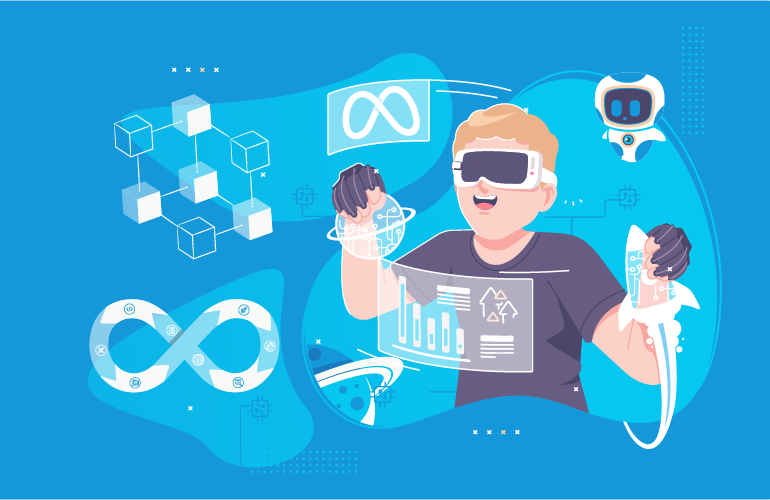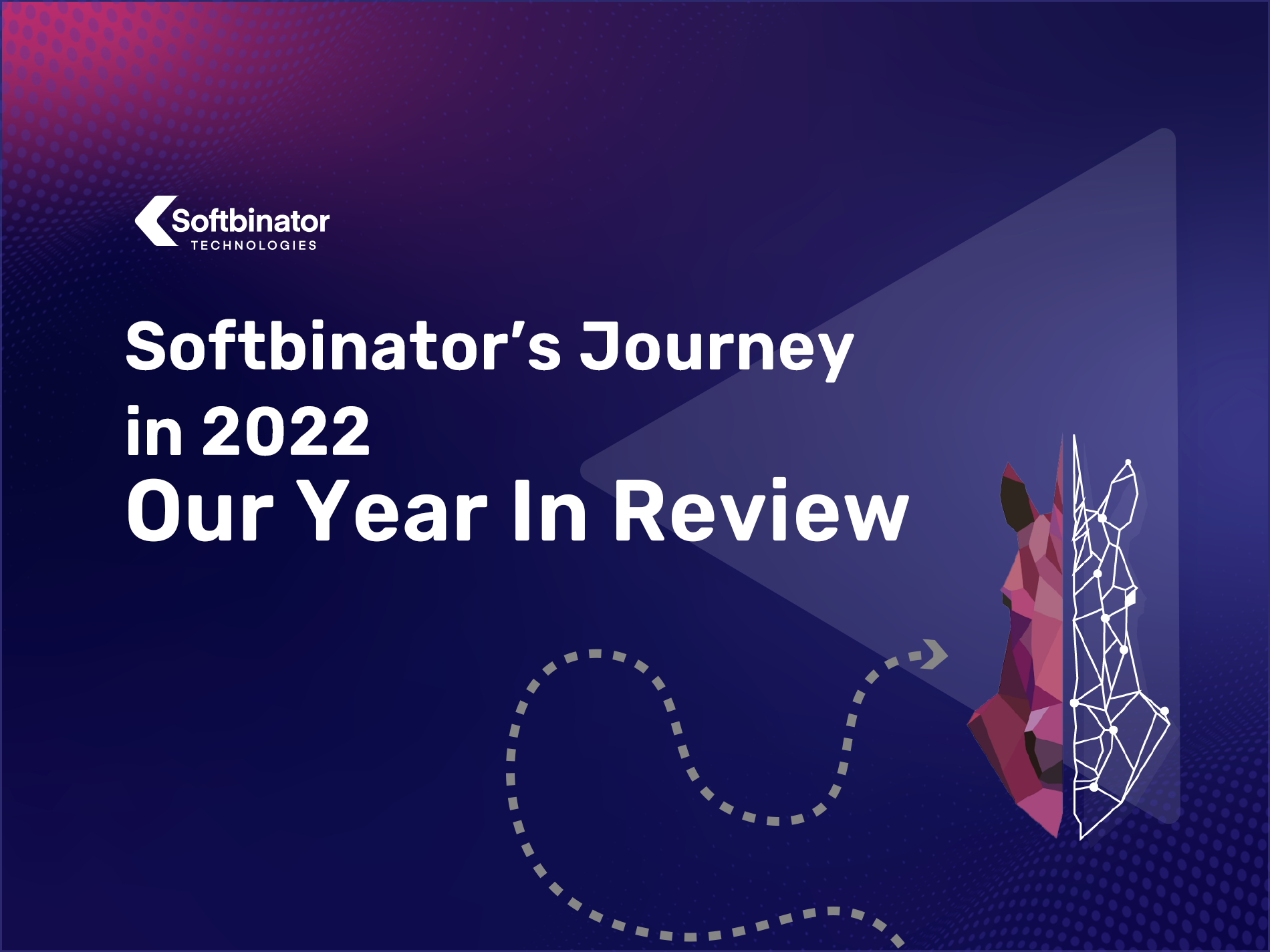
At Softbinator, we are all about keeping up with cutting-edge tech. We started out in 2011 with the mission to prove that developers are innovative creators. We’ve steadily grown and transformed into an R&D and consultancy business. As an Agile company, we’re customer-centric and make constant and focused changes that bring value.
Here’s on what we’ll keep a close look in the future.
We’ll Narrow Down on the World of Meta, Blockchain and DevOps
Whether it’s the products we invest in, or our worldwide clients we’re consulting, we make sure we always choose the right tech stack. Regardless of the type of tech solution or service, we define product value based on two essential verticals:
- the ability to align with the rapid shifts in the marketplace
- the power to keep up with the latest tech innovations.
And speaking of IT innovations, the last years have brought out new trends that we believe every tech company should keep a close eye. That’s why Softbinator will focus its work as well as keep you updated on what goes on in the world of Metaverse, Blockchain, and DevOps.
Meta’s Virtual Reality & More
Whether you hate it or love it, at the end of the day, Facebook (recently renamed Meta) has been a pioneer that significantly changed people’s digital lifestyle. This company was the one that created hysteria around the ‘Like’ button and cornered the concept of Timeline.
After its restructuring from 2021, the now Meta is the one that brings into the spotlight the idea of living your life in a digital sphere called Metaverse.
What is Metaverse? What does it actually mean?
The way it has been revealed so far, Metaverse is a virtual world that claims to simulate the real world to a great extent.
AR and VR are the baseline for metaverse projects. Augmented reality systems work based on three essential pillars:
- a mix of real and virtual environments
- real-time interaction
- precise 3D visualization of objects
Augmented Reality or AR is a combination of real-life and digital universe, enabling you to layer 3d virtual environments to the visual environment surrounding you. One example would be using digital holograms in a physical space.
Compared to AR, virtual Reality or VR allows you to immerse yourself in a digital world. With the help of advanced VR headsets, you’ll be completely surrounded by layers of 3D virtual environments. It is the combination of AR and VR, also known as Extended Reality (XR) that you would experience in metaverse VR apps.
The Metaverse is like a high-fidelity version of a website, with full-scale digital realities, currencies and economies; people portrayed like avatars make financial decisions with real-world implications, like selling digital products, interacting with each other virtually through a combination of AR and VR.
Gaming companies have amped up their virtual reality efforts to create realistic virtual worlds. Still, Metaverse can have plenty of other real-life use cases like:
- the healthcare sector: the next level of telemedicine, where doctors can interact with patients, consult them and prescribe treatments without the need for a physical contact;
- tourism: tourists can visit locations from the comfort of their own homes; they can see places that they normally can’t afford or can’t reach in real life for whatever reason. Access to a tourist location could simply require paying with a digital token.
- work training: train employees with the help of AR through projections of digital imagery – a technique that enhances a physical environment with digital information; as an example, digitally mapped simulations can help engineers see, check and validate component designs by simply tapping on parts of a projection to see more information.
Thus, the future looks bright for companies that plan to create AR apps or implement virtual reality features. With Metaverse becoming a hot topic, we’ll dedicate our efforts to help companies develop products focused on the VR/AR space – the first step towards integrating into a Metaverse-like world.
As with every new concept, Metaverse will have to pass the time test, see how companies will embrace it, and how it’ll bring value to the customers. We’ll watch Meta like a hawk and keep you posted.
Blockchain
Whenever you hear about blockchain, you instantly think about cryptocurrencies. But this is just one of the many applications of blockchain technology. At Softbinator, we’re paying close attention to any blockchain applications that rely on a decentralized ecosystem to create value and the future trends of this technology.
In 2021, new trends like NFTs, DAOs, L2 chains have emerged, gained a lot of traction, and seem to continue to expand rapidly.
NFT – The Rising Online Star
The NFTs are the new hype that has taken the online world by storm, from digital artwork to real estate properties. Gaming is one of NFTs’ most popular areas where assets can represent in-game items like avatars, digital and non-digital collectibles, domain names, and event tickets. NFTs are bound to take the gaming industry to a whole new level where players become the owners of their assets, and they can sell them for a profit on NFT marketplaces.
Additionally, NFTs can be used in various schemes and projects, like creating new subscription models and online social perks. One real-life example is US Time magazine that has started to experiment with NFTs as alternative digital subscription models. TIMEPieces replaces the digital subscription and offers NFTs from 40 distinct artists, making each owner a community member.
While many regarded NFTs as a speculative bubble, their utility will likely increase along with the rise and progress of the Metaverse and cryptocurrencies.
How DAO will Revolutionize the Future of Work
The future of work sounds pretty great based on DAO’s principles: an authentically flat organization, where each member or employee has an equal say in making decisions (including the very important ones). Additionally, whoever owns a DAO (decentralized autonomous organization) can have a direct transactional relationship with the audience, removing the need for any middlemen.
DAOs are managed from the bottom up, following a precise set of rules implemented on a smart contract in a blockchain, usually Ethereum. Some examples of current uses of DAOs are:
- Governance protocols for yield optimizers and lending platforms
- Investment and grants that operate with pooled funds or create new innovative projects
- Art collection – pool funds to buy pieces of digital art or even real-life antiques
- Social DAOs, aka community clubs, where users gain membership after purchasing a certain number of tokens.
Future DAO projects will inspire companies on how they should run their businesses. One of the upcoming trends will be that organizations will combine their physical products and services with their audiences’ virtual realities.
Improve Scalability with L2 Chain Solutions
The blockchain technology has to juggle with its 3 main properties (known as the Blockchain Trilemma):
- Security
- Scalability
- Decentralization
Since any blockchain system can only handle two properties at most, scalability is usually the one that’s always missed.
Yet, scalability is supporting a blockchain’s network ability to support high transactional throughput and growth.
Layer 2 chain solutions promise to shift a portion of a blockchain’s protocol’s transactional burden to a different system architecture that handles the network’s processing stage. This way, the base layer blockchain becomes less congested and more scalable. Layer 2 solutions will ultimately get high throughput without sacrificing network security.
We’ve embraced these three technologies and already partnered with multiple companies on these trends. Our 2022 strategy will strengthen these relationships, and we’re eager and happy to help whoever is looking to innovate in any area of blockchain technology.
DevOps and Cloud Solutions
Clearly, the cloud is here to stay and will continue to thrive. 2021 has been a challenging year for multiple businesses that either started their journey into building their product with a Cloud-first approach or migrated from an on-premise deployment to cloud architecture. At the same time, change is a constant feature in the cloud, so as a DevOps, you have to be flexible enough to adapt to new technologies and methodologies quickly.
Building Cloud architecture sounds fancy, but before reaching your final decision, you need to consider things like:
- What cloud provider do you want to use?
- What type of architecture do you plan to build?
- Are you going micro-services first, or are you starting with a mini-monolith approach?
- What scaling strategy will you use for your backend services?
- How do you plan to optimize your frontend for fast and reliable rendering?
When building cloud-based systems, it all goes down to making the right decisions. The resources you use determine what you’ll see in your cloud bill at the end of the month.
This may come as no surprise, but throughout our journey of helping customers build their tech stack on the cloud, they all faced the same bottleneck: optimizing the costs. You always have to find the right balance between adding new features and optimum scalability.
For this reason, our plan for 2022 is to make more and more of our existing and future customers to consider Lambda Functions and Kubernetes as part of their main cloud stack.
With Lambda, you can:
1. Adjust memory settings based on function behavior
If your function’s CPU utilization is high, decreasing the memory will make your function run forever. That’s why to reduce execution time, you increase the memory (and by extension, CPU) to process it faster.
2. Use Step Functions for processing delays
These state machines with a visual workflow allow you to coordinate various activities and tasks, like calling different Lambda functions, where you only have to pay for the number of state transitions required to execute your application, rather than the execution time of a workflow.
3. Write efficient code
Improve application performance and reduce costs by identifying an application’s most expensive line of code, and getting recommendations on how to improve code to save money.
4. Limit data transfer
Data transfers are charged at the standard EC2 rate, so you need to consider what data goes in and out of your Lambda function. The best way to do that is to always keep an eye on the amount of data you’re transferring out to the internet and other regions of AWS.

When it comes to Kubernetes, the primary ways you can optimize cloud costs include:
- Easy and cheap maintenance of applications
With the right setup and configuration, applications run with extremely low downtime and great performance without frequent support intervention. You can regularly monitor nodes and pods’ health state, launch new codes or reschedule them to a healthy node whenever needed. You can always make changes when the desired state is not achieved and launch new pods or reschedule them to a healthy node.
- Faster deployment times
Select the desired state of your deployments while the controller will deploy and maintain it.
- Efficient resource management
Kubernetes uses an efficient resource management model implemented at the container, pod, and cluster levels. You can assign resource requests and limits specified in raw CPU and RAM values to containers. Resource requests and limits ensure full control of cluster administrator over the resource utilization in the cluster.
- Decreased costs with autoscaling
Kubernetes can provide native autoscaling functionality implemented in the horizontal pod autoscaler (HPA). You can scale pods up and down, based on the ever-changing application load (CPU) and traffic or any other custom metrics. Additionally, the HPA can manage your infrastructure costs by scaling the number of pods in a replication controller, deployment, or replica set based on your metrics.
And these are just a few examples. There are plenty of other ways to save money when using the Cloud, as long as you take into consideration all the details related to Cloud Cost Optimization during the planning and implementation phases.
Don’t Miss Softbinator Updates
This is our roadmap for 2022. You’ll get to find out the ins and outs of these 3 major trends right here, on Softbinator’s freshly released blog.
We’ll bring you an in-depth overview in a series of future posts.
Stay close! You can find more about us on Facebook, Instagram, and LinkedIn.

 Softbinator’s Journey in 2022 - Our Year in Review
Softbinator’s Journey in 2022 - Our Year in Review